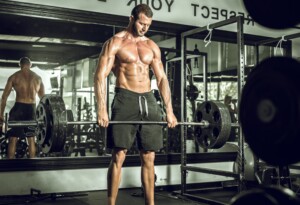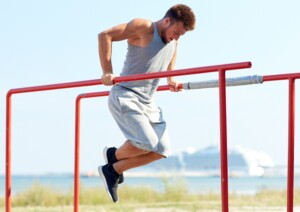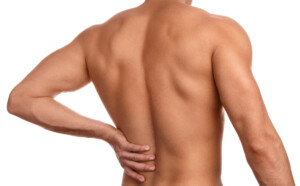The deadlift + bar dip will jolt your body into muscle growth.
The combination of these two exercises gives the body no choice but to grow.
Deadlift
The deadlift is an incredible exercise, known to cause major metabolic/hormonal changes in the body after a workout.
However, in order to achieve the growth jolt from the deadlift, you must use a significant load.
The Strength and Conditioning Journal (April 2010) says that the conventional deadlift works the gluteal muscles, quadriceps, hip abductors and spinal erectors.
The deadlift works the body’s power structure. Plus, other muscle groups such as the arms get involved in a supporting role.

Shutterstock/Ajan Alen
One big mistake is to try to lift the load with your low back. Instead, the hips, glutes, quads and hamstrings should carry the weight, with the low back participating but not being the main mover.
The glutes, hips and quads are the body’s power source and you want them, not the low back, moving the load.
When pulling the heavy load up with the deadlift it is very important to keep the back straight and to keep the weight load close to the body.
If you let the weight drift too far forward, you are much more susceptible to involving the low back and incurring injury.
Always focus on correct form – even after you have a hundred deadlifts under your belt.
If you have not deadlifted before, or if it has been some time since you’ve performed this routine, start off with a moderate load and begin working your way up.
You don’t need to use the typical range of 8-10, but instead try a powerlifting approach with a 3-7 repetition range.
Once you have the mechanics down, employ really heavy weight loads. The manner in which the deadlift successfully stimulates metabolism and causes muscle growth is from heavy resistance. A load that’s light won’t spark muscle growth.
Always warm up well and increase the load each consecutive set until the load becomes so heavy that you struggle with three reps.
Deadlifting puts a heavy load on the body (the only way to spark big muscle growth), so perform it 1-2 times a week, allowing for plenty of rest between sessions.
Dip
The dip is a compound exercise that features strength of the upper body. The primary movers are the triceps and the chest muscles. This is another exercise in which correct form plays a key role.

Shutterstock/Syda Productions
The issue with the dip is range of motion. Seeing someone perform a dip today is relatively rare, unless you count those using the dip-cheat machine (which allows a trainee to get an assist). And if they are performing the dip, many do fail to use a full range of motion.
Most people short-stroke the dip by not going all the way up for a full extension. They then compound the problem by failing to go down far enough. For the dip to be effective you need that full range of motion.
Wait until you can perform 20 repetitions of bodyweight-only good form before adding heavy weights with a weight belt. When you hit this mark you are ready for the weighted load—and more muscle growth.
The dip is a great way to build up powerful arms. Most of the muscle power and size in the arms lies in the triceps, and the dip (especially weighted) is a great tool for unlocking this power.
Perform 3-5 sets as part of your arms workout. Make the dip a priority by placing it at the front of your arm training session.
Dipping and deadlifting will really build the muscle and power you’ve been struggling to achieve.










































